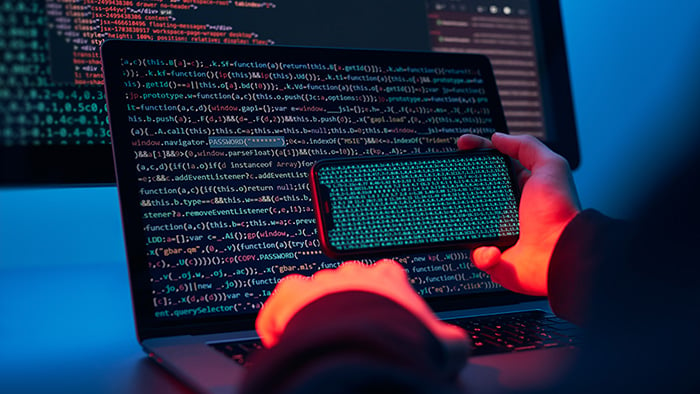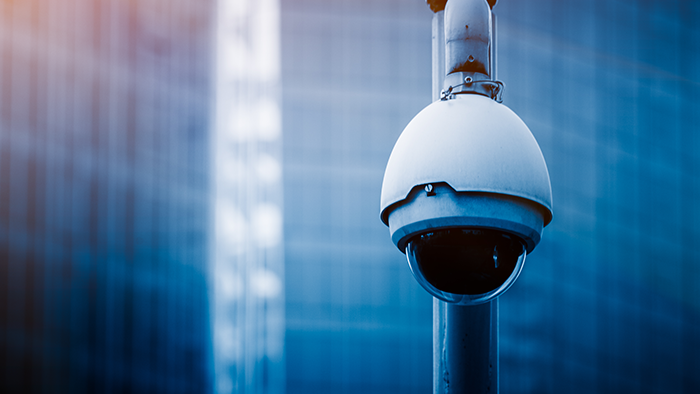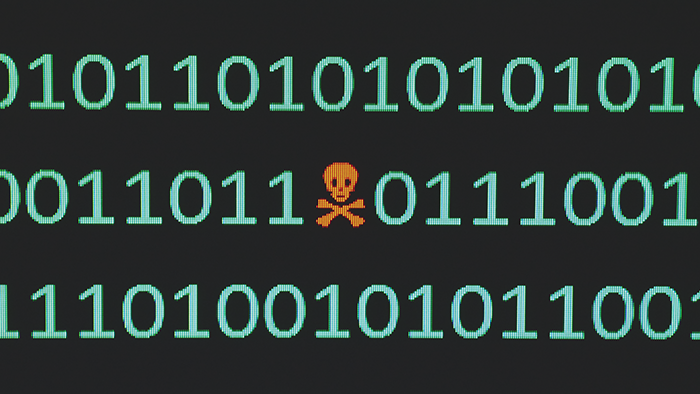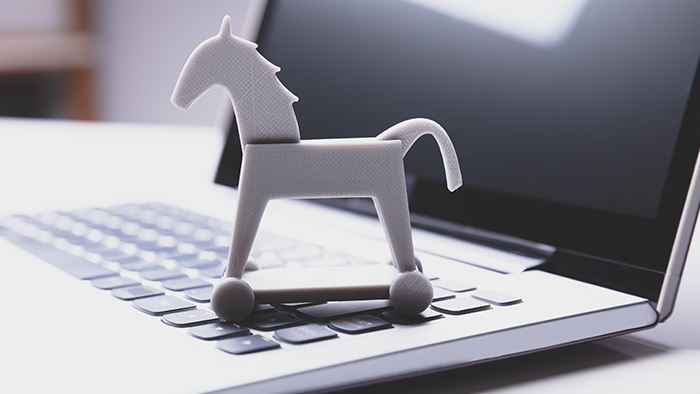What’s the difference between malware and a virus?
Malware is an umbrella term for any malicious software written specifically to infect and harm the host system or its user. A computer virus is just one type of malware. Just as all squares are rectangles (but not all rectangles are squares), all viruses are malware, but not all malware is a virus.
So if you’re wondering whether malware and viruses are the same thing, the answer is a firm “no.” The malware category includes viruses, spyware, adware, ransomware, and other types of harmful software. Knowing the differences between viruses and other types of malware is helpful when it comes to prevention as well as removal.
A computer virus is designed to copy itself and spread to other devices as widely as possible, just as a biological virus infects its host, self-replicates, and spreads to new hosts. Computer viruses proliferate by infecting applications and email, and they can be transmitted by removable storage, infected websites, email attachments, and even networking routers.
Exactly what the virus does depends on its level of sophistication. Simple malicious code damages your hard disk or deletes files. A more complex virus might hide on your computer and engage in unwanted activity such as spewing out spam. Highly advanced viruses, called polymorphic viruses, modify their own code to evade detection.
Above malware and viruses is a larger, overarching category: threats. Threats encompass malware, and also include other online threats like phishing, identity theft, SQL injection, and more.

Why are viruses and malware so commonly confused?
Confusion over the difference between virus and malware comes down to entrenched name recognition. Once a word or term becomes ingrained in the collective mindset, it tends to stick. Although cable TV regularly uses a digital video recorder, many people still refer to the recording process as “taping”, a throwback to the VHS days. Old habits die hard.
The first malware in the 1970s were dubbed “viruses”. The first antimalware programs published in the 1980s and 1990s were called “antivirus,” because that was the primary problem at the time; many such tools today continue to use that name, even though they protect against far more than viruses. That’s true for Avast One, too!
Does it matter if malware is the same as a virus if you don’t have any protection? Not really — without a strong antivirus, you’ll be vulnerable to all kinds of malware. Avast blocks over 66 million threats per day, and we’d be happy to keep you secure, too.
So there are other kinds of malware out there, too?
The cybersecurity landscape is evolving. Sadly, there are more “bad guys” than ever before, and they are motivated (financially and otherwise) to innovate. Viruses aren't the only risk facing internet users today:
-
 Worm: A self-replicating piece of malware whose primary function is to jump from computer to computer, often without doing anything beyond replication.
Worm: A self-replicating piece of malware whose primary function is to jump from computer to computer, often without doing anything beyond replication.
-
 Adware: Advertising spam that is designed to shower you with ads on your device in order to generate ad revenue.
Adware: Advertising spam that is designed to shower you with ads on your device in order to generate ad revenue.
-
 Scareware: It’ll tell you that your computer is infected with malware and prompt you to download a solution. Sometimes the download will itself be malware, and other times you’ll be pressed to pay for useless software.
Scareware: It’ll tell you that your computer is infected with malware and prompt you to download a solution. Sometimes the download will itself be malware, and other times you’ll be pressed to pay for useless software.
-
 Spyware: Just as the name implies, it spies on your actions, recording your keystrokes with the intent of stealing login credentials.
Spyware: Just as the name implies, it spies on your actions, recording your keystrokes with the intent of stealing login credentials.
-
 Ransomware: A newer and particularly nasty form of malware, ransomware locks up your computer, folders, or files and makes them inaccessible to you, essentially holding them hostage while demanding a ransom payment.
Ransomware: A newer and particularly nasty form of malware, ransomware locks up your computer, folders, or files and makes them inaccessible to you, essentially holding them hostage while demanding a ransom payment.
-
 Rootkit: The hardest to detect and remove, these kits bury themselves deep in your computer and perform a variety of illegal activities, including stealing user info (similar to spyware), sending spam emails, participating in DDOS attacks, or granting hackers remote access to your device.
Rootkit: The hardest to detect and remove, these kits bury themselves deep in your computer and perform a variety of illegal activities, including stealing user info (similar to spyware), sending spam emails, participating in DDOS attacks, or granting hackers remote access to your device.
Some of these overlap, and the distinctions can be confusing. For many people, ultimately it doesn’t matter. The point is that someone is trying to do bad things to or with your computer, and you just want them to stop.
What type of devices can be affected?
Malware can harm any kind of device, though depending on what you use, you’ll be at varying degrees of risk. Windows PCs are the most popular target because they are the most widely used computer systems. Mac computers were ignored by malware creators for years because of their then-lower market share, but as they grew in popularity, Mac malware began to appear as well.
Smartphones and tablets can also be infected by malware, despite their comparatively higher security. While you can only download apps on your iPhone via the official App Store, Android users aren’t as rigidly limited to Google Play. Still, while both companies patrol their stores diligently, malware sometimes manages to sneak through and infect a few unlucky souls before it gets taken down. If it happens to you, you can learn how to remove viruses from Android or iPhones.
It is also possible to get malware on your smartphone or tablet if you jailbreak it, which removes the device’s built-in protective walls. Generally, jailbreaking is only done by very advanced users who know how to do it and know the risks they are taking. Unless you’re one of them, think twice before jailbreaking your phone.
iPhone users are typically only at risk from malware if they’ve jailbroken their devices, while Android is much more prone to attack.
How can I tell which one I have?
Most malware does its best to avoid detection, though there are some types that rely on making their presence known. Ransomware, for example, blatantly informs you of an infection so that you’ll hopefully, from its creator’s point of view, pay the ransom they want. Other forms of malware, such as spyware, try to be as low-key as possible. Their purpose is to gather information, and it behooves them to do so without detection.
There are some common signs of a malicious infection, regardless of the type. One of the dead giveaways is that your computer suddenly begins to run very slowly. That often means a poorly-written piece of malware is sucking up your computer’s resources. Conversely, a slowing hard drive could also simply be on its way out, and while you’d be spared the malware infection in this case, you’ll still need to take action to save your data.
There are, of course, other reasons beyond malware that can cause your computer to have performance problems, and we offer advice about how to speed up your Windows PC, ways to improve MacOS performance, and hard disk performance processes. But you should always start by checking whether the system is infected with malware. And since many malware applications block antimalware software installation, ideally you’ll have already installed a malware removal tool on your computer.
Because so many types of malware display similar symptoms, it can be tricky to identify the precise variant on your device — unless, like ransomware, it tells you. Regardless of the malware you’re dealing with, it’s imperative that you take immediate steps to remove it from your computer and prevent it from spreading to additional devices on your network.
Do I need both antivirus and malware protection?
In this day and age, the two are one and the same — there’s no distinction when it comes to antivirus vs. antimalware. Nobody’s offering software that detects and removes viruses while ignoring worms, Trojans, spyware, and ransomware. Even if the product name says “Antivirus,” a close reading should reveal that it offers wide-ranging protection (and if not, don’t use it).
Good antimalware software packages also monitor email clients and web browsing, and maintain a database of known and reported dangerous sites. If you try to visit a site known to carry a malicious payload, your antivirus software stops you from even loading the website.
Likewise, if a suspicious attachment comes in via email, your antivirus software detects it and moves the attachment to a quarantine folder where you are barred from opening it. If you verify that the attachment is legitimate, you can move the file to a regular folder and mark it in the antivirus program as erroneously flagged for future reference.
A single solution for both malware and viruses
You shouldn’t need to worry about the precise type of malware that is attempting to infect your system — you want to avoid all of it! The best way to both prevent a malware infection and recover when something goes wrong is with robust antivirus software.
Avast One offers comprehensive detection and prevention against viruses, malware, spyware, ransomware, phishing, and other threats, making it a reliable solution for all-round protection. Place your cyber-safety in the hands of an industry-leading antivirus provider.









/What-is-scareware-and-how-to-remove-it-Thumb.jpg)





